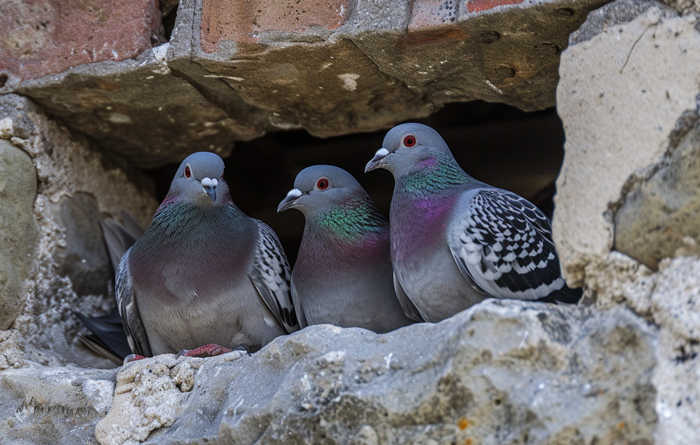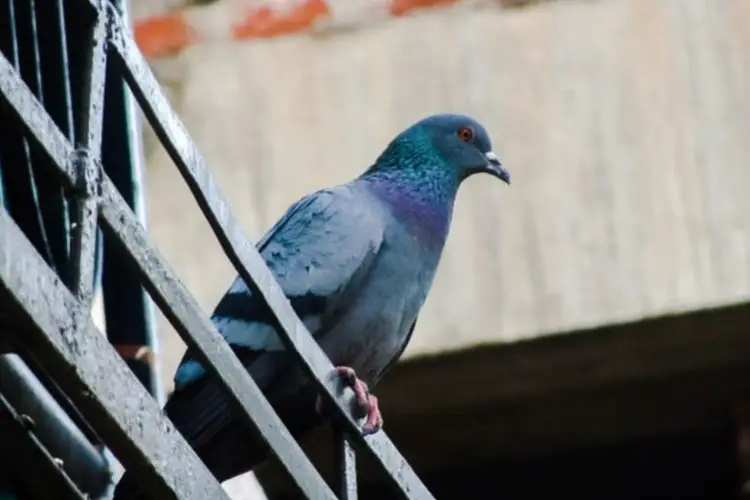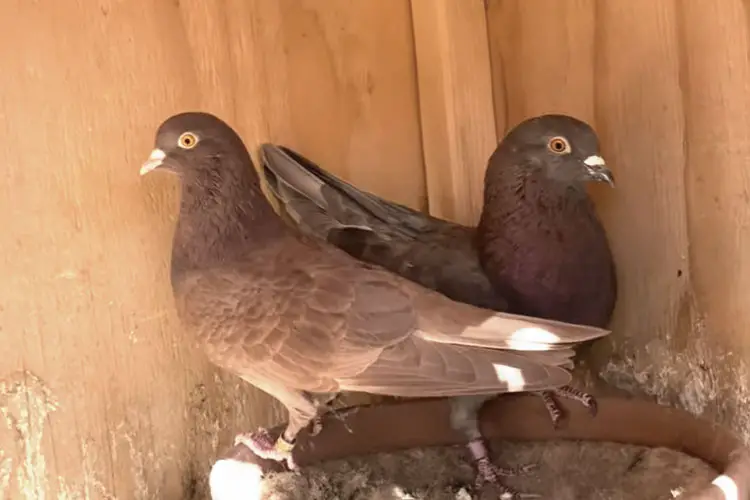Why Do Pigeons Keep Coming Back? Tips for Peaceful Coexistence
Are you tired of constantly finding pigeons flocking to your house? Trust me, I’ve been there. It can be frustrating and even a little perplexing. But fear not, because I’m here to shed some light on this avian mystery. In this article, I’ll delve into the reasons why pigeons seem to have a special affinity for your humble abode. From their innate homing instincts to the allure of food and shelter, we’ll explore the fascinating world of pigeon behavior and uncover the secrets behind their persistent return. So, grab a cup of coffee, sit back, and let’s solve the mystery of why pigeons keep coming back to your house.
Pigeons, those feathery creatures with an uncanny ability to find their way back home, have a knack for choosing certain locations as their regular hangouts. And it seems like your house has become their favorite spot. But why? Well, my friend, it turns out that pigeons are highly social creatures, and your house might just offer them the perfect combination of comfort and companionship. From the cozy nooks and crannies to the familiar sights and sounds, your home provides a sense of security and familiarity that these birds find irresistible. So, don’t be surprised if you find yourself playing host to a flock of pigeons on a regular basis. But fear not, because in this article, I’ll share some tips on how to peacefully coexist with your feathered friends.
The Innate Homing Instincts of Pigeons
Pigeons are fascinating creatures with a strong homing instinct that allows them to navigate their surroundings with incredible precision. This instinct is deeply ingrained in their DNA and plays a significant role in why they keep coming back to your house.

Here’s what you need to know about the innate homing instincts of pigeons:
- Navigation Abilities: Pigeons have an exceptional ability to navigate through the use of various cues, including the Earth’s magnetic field, the position of the sun, and even visual landmarks. These tools enable them to create a mental map of their environment and find their way back to familiar locations.
- Social Nature: Pigeons are highly social creatures, and they thrive in groups. They often establish strong bonds with other pigeons and form close-knit communities. Your house may have become a familiar meeting point for pigeons, offering them a sense of companionship and security.
- Nesting Behavior: Pigeons have a strong nesting instinct, and they prefer to build their nests in safe and secure locations. If your house provides suitable shelter, such as ledges or eaves, pigeons may be drawn to it as an ideal nesting spot.
- History of Coexistence: Pigeons and humans have a long history of coexistence. Over the years, pigeons have adapted to urban environments, where they find abundant food sources and suitable roosting spots. Your house may offer them a comfortable environment with easy access to food and water.
Understanding these innate homing instincts of pigeons can help us better comprehend why they keep coming back to your house. While their presence may seem unwanted to some, it’s essential to remember that pigeons are intelligent creatures just trying to survive in their own way.
The Allure of Food and Shelter
When it comes to understanding why pigeons keep coming back to your house, one of the key factors to consider is the allure of food and shelter. Pigeons, like any living creature, are driven by their basic needs, and your house might offer the perfect environment for them to find both nourishment and a safe place to nest.

Abundant Food Sources
Pigeons are opportunistic feeders, meaning they can adapt their diet to whatever food is readily available. In urban settings, pigeons have learned to take advantage of the abundance of food sources provided by humans. Whether it’s unattended bird feeders, scattered crumbs, or even discarded food, pigeons will happily feast on whatever they can find.
Suitable Shelter
Alongside food, pigeons require suitable shelter for nesting and roosting. Your house might offer the ideal spot for pigeons to build their nests and raise their young. Pigeons prefer ledges, balconies, and other elevated areas that provide protection from predators and the elements. The architecture of human structures often provides these suitable nesting spots, making your house an attractive option for pigeons seeking a safe haven.
Cozy Nesting Spots
Beyond providing shelter, pigeons are instinctively drawn to cozy nesting spots where they can feel secure and comfortable. Your house may inadvertently provide these ideal conditions. Pigeons’ strong nesting instincts make them seek out secluded areas where they can lay their eggs and care for their young without disturbance. The warm corners and nooks of your home may offer the perfect setting for them to create their nests.
The Attraction of Your House
Understanding the allure of food and shelter can help explain why pigeons keep coming back to your house. The abundance of food sources, the suitable shelter, and the cozy nesting spots make your house an irresistible location for pigeons to settle and thrive.
In the next section, we will explore some tips on peacefully coexisting with pigeons to ensure a harmonious living arrangement. But first, let’s delve into another aspect that attracts pigeons to your house – their social nature.
Social Behavior and Companionship

When it comes to understanding why pigeons keep coming back to your house, it’s essential to consider their social behavior and need for companionship. Pigeons are highly social creatures that thrive in groups, and forming strong bonds with their flock is crucial for their well-being. Here’s a closer look at their social behavior and how it relates to their attraction to your house:
- Flocking: Pigeons have a natural inclination to flock together with their own kind. By congregating in flocks, pigeons benefit from increased protection against predators and gain access to shared resources such as food and shelter. Your house might serve as a reliable gathering place, especially if there are other pigeons already frequenting the area.
- Roosting and Nesting: Pigeons are known for their ability to adapt to various nesting sites, and human structures often provide appealing options. Pigeons prefer elevated areas with ledges or flat surfaces where they can build their nests. Your house might offer exactly what they need – a cozy, safe, and elevated spot for roosting and nesting.
- Companionship: Pigeons crave companionship and find comfort in the presence of other pigeons. Your house with its existing pigeon population may serve as a gathering spot for these social birds. The flock dynamics and the companionship they find in your area might be a strong motivating factor for them to keep returning.
By understanding the social behavior and need for companionship of pigeons, we gain insights into why they continuously visit your house. However, it’s important to remember that coexisting peacefully with pigeons is possible. In the next section, I’ll provide some tips on how to maintain a harmonious relationship with these feathered neighbors without resorting to drastic measures.
Comfort and Familiarity
As I mentioned earlier, pigeons are highly social creatures that thrive in groups and form strong bonds with their flock. One of the reasons why they keep coming back to your house is the comfort and familiarity it provides.
Pigeons are drawn to areas where other pigeons are already frequenting. Your house acts as a gathering spot because it’s already inhabited by pigeons. This sense of community and companionship is important to them, and they find comfort in being around other pigeons.
In addition to seeking out fellow pigeons, these birds also prefer elevated areas with ledges or flat surfaces for roosting and nesting. Human structures like houses often provide these ideal roosting spots, making your house even more appealing to them.
Furthermore, when pigeons gather in a particular area, it creates a familiar environment for them. They become accustomed to the surroundings, recognizing landmarks and establishing a routine. This familiarity makes them feel secure and at ease, which is another reason why they keep coming back to your house.
It’s important to understand that pigeons aren’t intentionally causing any harm or inconvenience to you. They are simply driven by their natural instincts and social behavior. By recognizing their need for comfort and familiarity, we can find ways to peacefully coexist with these fascinating creatures.
Next, let’s explore some practical tips on how to discourage pigeons from frequenting your house without causing them harm.
Tips for Peacefully Coexisting with Pigeons

As someone who has dealt with pigeons frequenting my house, I understand the desire to find ways to peacefully coexist with them. Here are some tips that can help you maintain a harmonious relationship with these feathered neighbors:
- Keep your property clean: Pigeons are attracted to places with ample food sources. By ensuring that your property is clean and free from food waste, you can discourage pigeons from lingering around your house. Store garbage in secure containers and clean up any spills or crumbs promptly.
- Remove potential nesting spots: Pigeons love to build their nests in cozy nooks and crannies. Take proactive measures to block off any potential nesting spots on your property. Secure access to vents, chimneys, and eaves to prevent pigeons from setting up their homes.
- Seal off entry points: Pigeons can be crafty and find their way into narrow openings and gaps. Inspect your house for any openings that pigeons could use to gain entry. Properly seal off these entry points to prevent pigeons from roosting inside your home.
- Install deterrents: There are various deterrents available in the market that can discourage pigeons from frequenting your property. These include bird spikes, bird netting, and ultrasonic devices. These deterrents create an uncomfortable environment for pigeons, encouraging them to find alternative roosting areas.
- Use visual repellents: Pigeons are sensitive to certain visual stimuli. Using reflective objects like shiny balloons, CDs, or wind chimes can deter pigeons from roosting on ledges and windowsills. They can also be startled by moving objects like fake predators or owl decoys.
- Scare tactics: Pigeons are wary of sudden loud noises or movements. Utilize scare tactics such as clapping, banging pots and pans, or using motion-activated sprinklers to startle pigeons away from your property.
Remember, it’s essential to approach pigeon control with patience and persistence. By implementing these tips, you can create an environment that is less appealing to pigeons, encouraging them to seek other locations for their roosting and nesting needs.
Conclusion
By implementing the tips mentioned in this article, I’ve been able to peacefully coexist with the pigeons that used to constantly flock to my house. Keeping my property clean and free from food waste has discouraged them from lingering around. Blocking off potential nesting spots and sealing entry points has prevented them from setting up their homes inside my house.
Installing deterrents and using visual repellents, such as reflective objects or fake predators, has created an uncomfortable environment for the pigeons. Scare tactics, like loud noises or motion-activated sprinklers, have also startled them away.
I’ve learned that patience and persistence are key in creating an environment that is less appealing to pigeons. It may take some time for them to get the message, but with consistency, I’ve been able to significantly reduce their presence around my house.
So, if you’re wondering why pigeons keep coming back to your house, remember that with a few simple strategies, you can discourage them from making your property their hangout spot.






